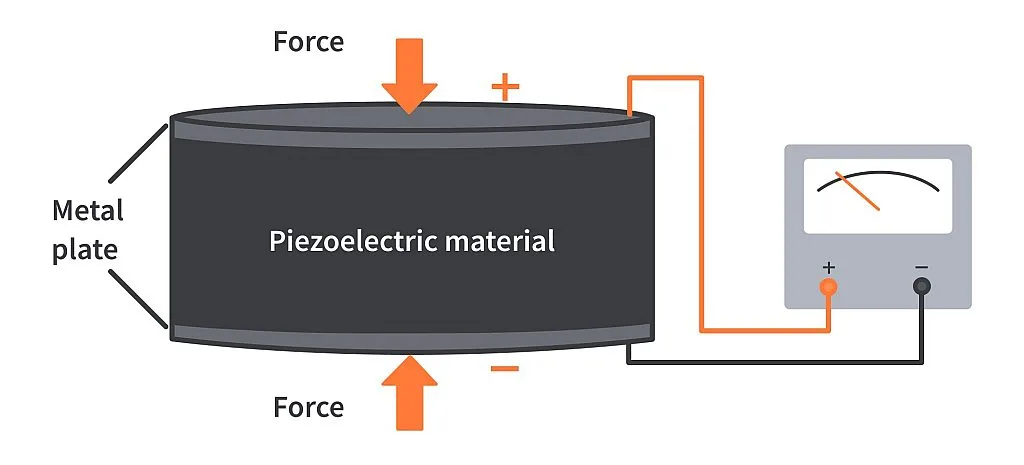Security Alert System Based on Piezoelectric Polymer Nanocomposite | 30 Aug 2024
Why in News?
Recently, the researchers from Centre for Nano and Soft Matter Sciences (CeNS) and National Chemical Laboratory (CSIR-NCL), Pune have developed a novel piezoelectric polymer nanocomposite for pressure sensing and energy harvesting.
- This can efficiently convert mechanical energy into electrical energy opening new avenues for applications in energy harvesting and pressure sensing.
What are Piezoelectric Polymer Nanocomposite?
- Piezoelectric Materials/ Effect:
- Piezoelectric materials are materials that can produce electricity when applied to mechanical stress. When pressure is applied to such materials, the centres of positive and negative charges shift, creating an external electric field.
- Examples:
- Natural materials: Quartz, topaz, and tourmaline.
- Organic materials: Silk, wood, and bone.
- Ceramics: Lead zirconate titanate (PZT) and barium titanate (BT).
- Polymers: PVDF and PVDF-TrFE.
- Ferroelectric materials: Barium titanate (BaTiO3) generates electric charge without mechanical pressure.
- Applications:
- Piezoelectric materials are used in various applications, including microphones, electric pickups for stringed instruments, sensors, actuators, frequency standards, piezoelectric motors, and noise and vibration reduction.
- Polymer:
- A polymer is a large molecule composed of chains or rings of linked repeating subunits called monomers, typically having high melting and boiling points due to their high molecular masses.
- Natural polymers include silk and DNA, while synthetic polymers, like nylon and polyethylene, are made from oil or bio-based sources.
- A polymer is a large molecule composed of chains or rings of linked repeating subunits called monomers, typically having high melting and boiling points due to their high molecular masses.
- Piezoelectric Polymers:
- These are polymers that can generate electric charges on the surface under pressure/strain thus converting mechanical energy into electrical energy.
- Example: Poly(vinylidene fluoride), also known as PVDF, Poly(vinylidene fluoride-trifluoroethylene) copolymer or P(VDF-TrFE).
- Polymer Nanocomposites: These are materials made from polymer matrices combined with small percentages of nanometer-sized additives, aimed at enhancing the properties of polymers such as mechanical, thermal, and electrical characteristics.
- Nanomaterials are the material having structural components with at least one dimension in the nanometer scale, that is, 1-100 nm.
- Nanocomposite is a solid material made up of two or more different substances, where at least one of these substances has dimensions in the nanoscale range, specifically between 1 nm and 3 nm.

What are the Key Facts About the Study?
- About:
- The researchers aimed to study how the different crystal structures of the zirconia nanoparticles affected the piezoelectric capabilities of the composite material.
- Process:
- Researchers created two types of zirconia-based Metal-organic frameworks (MOFs) (UiO-66 and UiO-67) and converted them into zirconia nanoparticles.
- Metal-organic frameworks (MOFs) are crystalline materials composed of metal ions or clusters linked to rigid organic molecules, resulting in one-, two-, or three-dimensional porous structures.
- Then these nanoparticles are mixed with a piezoelectric polymer called poly(vinylidene difluoride) (PVDF) to make polymer nanocomposite films.
- Researchers created two types of zirconia-based Metal-organic frameworks (MOFs) (UiO-66 and UiO-67) and converted them into zirconia nanoparticles.
- Findings:
- Researchers found that the surface properties and crystal structure of the nanoparticles significantly influenced the piezoelectric performance of the polymer.
- Practical Applications:
- Security Alert System: A Bluetooth-based security alert system uses a piezoelectric pavement prototype that generates voltage from footsteps.
- If unauthorised entry is detected, the system activates and sends alerts to a connected device, like an Android smartphone, via Bluetooth.
- Electricity Generation: The prototype can also generate electrical energy from mechanical energy input.
- This feature is particularly beneficial in enhancing the efficiency of energy use in smart cities and automated security systems.
- Security Alert System: A Bluetooth-based security alert system uses a piezoelectric pavement prototype that generates voltage from footsteps.
UPSC Civil Services Examination, Previous Year Question (PYQ)
Prelims:
Q. Consider the following statements: (2022)
- Other than those made by humans, nanoparticles do not exist in nature.
- Nanoparticles of some metallic oxides are used in the manufacture of some cosmetics.
- Nanoparticles of some commercial products which enter the environment are unsafe for humans.
Which of the statements given above is/are correct?
(a) 1 only
(b) 3 only
(c) 1 and 2
(d) 2 and 3
Ans: (d)
Q. There is some concern regarding the nanoparticles of some chemical elements that are used by the industry in the manufacture of various products. Why? (2014)
- They can accumulate in the environment, and contaminate water and soil.
- They can enter the food chains.
- They can trigger the production of free radicals.
Select the correct answer using the code given below:
(a) 1 and 2 only
(b) 3 only
(c) 1 and 3 only
(d) 1, 2 and 3
Ans: (d)

